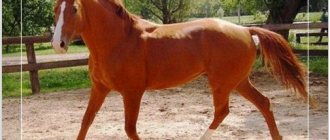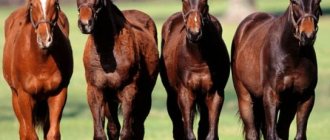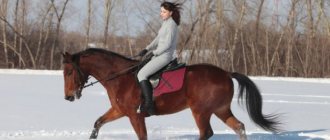19.07.2016
Unusual ride
Different breeds of horses have different types of gait, which are called gaits. They differ from each other in the way they move and position their limbs during movement, and in the speed of movement. And among all types of gaits, gallop is considered the fastest. The French interpret the term “gait” in Russian as “gait”. In addition to divisions into the variety of such gaits, each type of gait also has subspecies. Only an experienced horse breeder or rider who has been in contact with horses for a long time will be able to remember all these classifications and independently determine each of them.
Basic horse gaits
A little more theory. The three main gaits are walk, trot and canter. Spare me the scientific characterization of the rearrangement of legs at each gait. The horses know this even without us.
But this does not mean that you should not carefully monitor the rhythm and the entire process of movement as a whole. Try to determine how the tired, sluggish trot of a horse under an inexperienced rider differs from the high, sweeping and springy trot of a skilled rider. This is noticeable in the horse from the tips of the ears to the tail!
Three gaits are not everything. There are a number of nuances, depending on whether the rider and horse are moving smartly and collectedly or slowly and freely. So, in a step, a “free” and “collected” step are distinguished.
- At the same time, free walking means the type of movement when the horse walks as if on its own, without obvious intervention from the rider.
- A collected walk is called when the horse is ready to move, truly “holds” its head and tail, and walks with a high, springy step.
When trotting, the stride lengthens, the order of rearrangement of the legs and, above all, the force of the push (the rate of passage of a normal section of the path) changes through a distinct acceleration of the normal trot to an extended one. But even here the difference between collected and extended trot is revealed. True, the extended trot is more suitable for rough terrain, while in the arena it is better to ride at a collected trot. But even in the arena, from time to time the horse is allowed to trot freely for relaxation.
- If the rider remains firmly seated in the saddle at each trot pace of the horse, then such a seat is called “training” or (less often) “German”.
- If, after each trot pace, the rider seems to stand up in the stirrups, then this is called a “light” trot (or “English” seat).
There are also three options in gallop: the pace increases (at the same time the speed also increases) from the dressage canter (short gallop) to the working gallop and to the extended gallop. While the walk and trot of the right and left legs are basically the same, in the canter there is a left and right canter. These names correspond to the “leg” with which the horse starts off.
- If the horse starts from the front left (from the inside leg in relation to the center of the arena), they speak of moving “from the left leg”. And vice versa.
- If the horse starts from the outside leg (in relation to the center of the arena), then they speak of a counter canter.
Tempo is the continued rhythm of a step sequence. So the horse takes approximately 100-130 steps per minute. This rhythm can be slowed down or speeded up. By the term tempo, riders do not mean a faster beat, but the different intensity with which they walk in one gait (for example, normal or shortened trot). It is expressed in the height and width of an individual step. At the same speed, the step can be free and extended or collected, that is, shortened.
Beyond Basic Skills
These skills go beyond the basics. Learn to fall and perform emergency dismounts under the supervision of a knowledgeable trainer. Always wear a helmet and appropriate boots or safety stirrups. Consider using a chest protector and mouth guard as well.
- Reining a Horse: There are many situations where it needs to be used.
- Bareback Riding: Riding bareback is fun and warmer in the winter!
- How to fall: Emergency dismounts and falls can help you if your horse is misbehaving. Although there is no surefire way to prevent accidents and injuries while riding.
- How to do an emergency dismount: A trainer can teach you how to get off your horse quickly.
Horse control commands
Now about the teams. They consist of two parts, professionally speaking the “preliminary” and “executive” teams. Between them you are given a short period of time so that you and your horse prepare to carry out the command. It is always clear from the preliminary team what the executive team will be like.
- At the command “Group, march,” the group begins to move at a step, simultaneously, and not like cars at a traffic light.
- “Trot, march” and “Gallop, march” indicate the transition to the next gait.
- “Short trot, march” or “Short stride, march” means the opposite.
- And finally, the command “Group, stop” stops the movement.
Of course, horses can be raised to a gallop from a walk, stopped from a trot (even from a gallop). You can even lift a standing horse into a gallop, though only a single rider, not a group.
Who would like to ride a horse?
For children . Most children will be delighted to ride a horse, and conversations about the adventure will not stop for a long time. Ask the instructor for permission to treat the horse with an apple or carrot and the child’s happiness will be limitless.
Girls or young couples . In addition to skating, many clubs offer the services of a professional photographer. A romantic photo shoot in nature will be the envy of all your friends.
For lovers of new things. Riding on horseback will give you sensations that you will not get anywhere else. It is compared to flying, climbing a mountain, parachute jumping, but only in terms of emotional intensity - the complex of impressions is unique.
For small riders - small horses. In the pony club, the child has fun, plays sports and learns to find mutual understanding with animals
Getting started: how to get started?
Remember: before we began to explain to you the theoretical positions of landing and sending, you were sitting in the arena on a horse, holding the reins correctly in your hand, the harnesses were not twisted - and were waiting for everything to begin.
Whether a person is working out in the arena alone or in a group - how does he get going?
It’s very simple: the lower back is arched, at the same time both legs are pressed near the girth, the reins are slightly released. Perhaps the horse will actually start moving - along with the others, just for company. And if not? You try again - and again to no avail. Do not despair! This is not a protest or evidence of its exceptional evil.
Somehow she recognized the newcomer in you: the three messages have not yet been agreed upon. Perhaps, expecting the horse to start moving, you leaned forward. Or even tightened the stomach. Or they “let go” of the reins (instead of first picking them up and then loosening them by 1 - 2 cm).
Luckily, you have a whip. The next time you try, lightly hit the horse on the shoulder with it. Be determined, the whip will not break! And no horse can stay in one place forever. Please do not be nervous, even if the coach is not in the best mood today. While remaining calm, remember that you should:
- sit up straight without hunching over;
- Tighten your lower back, bend slightly, pull the reins slightly;
- simultaneously press both legs (if necessary, even kick the horse’s body) and again release the reins a little. Perhaps help with a whip.
Well, you see. You should also practice moving your horse. And then one day everything will happen exactly as smoothly and naturally as was described at the very beginning.
How to use a whip?
Let me say a few more words about the whip and its use. The fact that for the arena and for training riding you need a long whip was said at the very beginning. Now you gradually understand why it is long: the whip should reach the horse’s croup so that you don’t have to let go of the reins.
At the very beginning, you can get by with a shorter whip; and with it, as a last resort, you can hit the horse on the shoulder. The deeper you become familiar with the processes of movement, the more differentiated you use the whip. And one more thing: the blow must be sharp and strong enough, and at the same time you must not lose control of the reins. It makes no sense to first shift the reins to the left hand and then try to reach the horse’s croup with a short whip. That's when the horse will definitely take off. This means that control over the horse is weakened: the connection with the horse's mouth is lost.
Horse movement at a walk
Focusing on the rhythm, quietly count the steps: 1,2, 1,2. You will feel the horse's body moving left and right. Do not “drum” your legs, but try to alternately press them on the horse’s body, in the area of the girth. This is called pushing. This should happen automatically - all the time you walk. Only in this case will the horse have the correct high and free stride, and you will actually move at a walk. Otherwise, you will encourage your horse to move in a way that has nothing to do with a sporting gait.
Can you feel the horse moving in your hips?
Balance this gentle sway with a gentle movement of your body. Your upper body should not sway. Don't rock back and forth with every step your horse takes. Not only does it look unsightly, but it also makes it harder for you to control the reins!
Horses nod their heads as they walk, some more, others less. Try as much as possible to break your horse of this habit. The horse should neither bump into the reins nor pull it out of your hands with each step.
Intermediate question: Have you forgotten that the legs should lie quietly next to the horse’s body in the girth area? And that you should pull your heels down and your toes up?
During the first two classes you will have plenty of time to take care of yourself. But then you have to start driving vigorously. It is necessary to ensure that the horse arches its back, then it will be more comfortable for you to sit. To do this, you need to know the language of the message. In horseman's language this is called “pushing”. If you move the reins (mainly the inside reins, the outside should “freeze”), pull on the reins and release it, and so on three, or even four times, while the horse walks along the long side of the arena. If the horse is chomping at the bit, it means you have trained it. This means that the natural connection with the horse's mouth is established: your horse is at least controlled by the reins.
In the end, there is a consolation: walking with a beautiful, free gait is not so easy - and experienced riders have a lot of worries before their horse learns to “put out its legs” correctly and begins to perform with a springy, sweeping step, as required by the management.
Precautionary measures
A novice rider should learn to gallop with his horse under the supervision of an experienced trainer.
For the safety of both rider and horse, it is necessary to:
- start galloping on a horse that walks in a circle using a cord;
- do not ride a horse without a helmet;
- Under no circumstances should you shout or squeal while running fast, so as not to frighten the horse, which may “carry away”;
- do not lean forward too much (which is completely unacceptable and can lead to the rider flying over the animal’s head during a sudden stop);
- do not allow the galloping horse to lower its head.
To learn how to gallop on a horse, you will have to put in a lot of physical and nervous effort.
Important!
Under no circumstances should you water your horse after a long race earlier than 1.5-2 hours.
However, the result of tedious training will be not only the invigorating clatter of hooves, the whistle of the wind in your ears and the creaking of the saddle, but also an exciting feeling of unity with this beautiful animal.
Stopping a horse on command
On the command “Group, stop!” riders stop their horses. The spacing between horses should remain the same as when moving (horse body). Stop commands are similar to those given when moving away. You should:
- straighten up and tense your lower back;
- Use both legs to squeeze the horse’s sides in the girth area;
- Pull both reins simultaneously and then loosen (repeat if necessary).
As you already know, by slightly loosening the reins at the start of the movement, you “stimulate” forward movement. Now you act in the same way - but pulling the reins more sharply until the horse stops. But do not lean back like a coachman and do not tear the reins: it is tightened by simultaneously turning your fists. If the horse does not stop, then the fist movement must be repeated; but act gently! Motto: In a tug of war, the horse is still stronger.
This holding of the horse to a stop is called a full stop. Don’t forget about voice commands, calm the horse. Only when the horse has stopped can the arms, body and legs be “relaxed”.
When stopping, the horse should stand on all four legs, the load on them is distributed evenly. The front and rear legs should be level. When you stop, you may think that the horse in front of you is larger than you. In reality, after the horse “brings” its hind legs under the body, its hindquarters appear to be lower. It is wrong to stop a horse by simply pulling on the reins; the legs must be pressed tightly against the horse's body.
Restraining the horse (switching to a slower gait) is carried out in the same way as stopping, but does not lead to a complete stop. Thus, “holding” or “full” stopping are different things, you must be able to get the horse to comply with both commands. Depending on the situation and the horse, when restraining and stopping, both reins are pulled either simultaneously or alternately. And, if necessary, they are released one by one, either once or several times. This is a matter of intuition and experience. But under no circumstances should you stubbornly pull the reins towards yourself; pick up and release them alternately.
And please, when working with the reins, do not forget to use your body! “Containment” (collection) transfers the horse to a slower gait, that is, from a gallop to a trot, from a trot to a walk. In addition, restraining the horse is used to transfer from an extended gait (walk, trot, gallop) to a shortened one. Therefore, every time, before you demand something new from your horse, first “collect” it, that is, prepare it for the next command. The movement of the group is resumed by the command “Group, march”.
Schenkel
Controls the horse's hindquarters, turns, maintains balance and forward movement. You cannot hit the horse with your legs or hit your heels uncontrollably on the sides. To send, pressing your leg tightly to your side is enough. The main action of the leg is sending forward. To do this, the rider presses both legs closely just behind the girth. The leg behind the girth at a distance of approximately 15-20 cm controls the movement of the hind legs during the turn. Also, this movement dictates or prohibits movement to the side.
The horse must be able to quickly respond to the slightest instructions from the rider. Otherwise, for poorly trained horses, as well as to strengthen the team, spurs and a whip are used as additional means of control. A horse whip is used in case of disobedience to a leg signal. However, they cannot hit the animal, but only with a light slap on the croup or shoulder to draw attention to your team. Spurs provide an additional means of pushing the horse's legs, but they should not be used by inexperienced riders.
The correct position of the leg in the stirrup is the key to ensuring that the horse understands your command correctly.
Training trot for horseback riding
The transition from walk to trot is performed in the same way as starting off. If the command “Group, training trot, march!” is given, you need to “collect” the horse by pulling on the reins and pressing your legs. And at the command “March!” you arch your lower back even more, give an energetic push with your legs (a whip is allowed, but is not the main means!) and at the same time weaken both reins so that the horse begins to trot.
When transitioning to a trot from a standing position, your message should be even more energetic and decisive, so that from the first steps the horse begins to trot. In the first lessons this will not work out right away. But later, after three attempts, the horse should trot.
A group of riders, when switching to a trot, as well as when starting from a standstill, should not “scatter”. When trotting, an appropriate distance must be maintained between riders, since at first it is difficult for you to control the horse, restraining or, conversely, sending it depending on the situation.
At the training trot you should sit tightly in the saddle. This means that at each trot pace you should lower yourself gently into the saddle. Like any beginner, you will feel shaky at the trot at first. The reasons are described above in the “Balance” chapter, as well as ways to avoid this. And one day you will be so comfortable in the saddle that you can carry a glass of water at a trot without much risk to yourself. Let's add: this will take time.
We remind you again: please do not tense your muscles, sit in the saddle as relaxed as possible, try to feel the rhythm of the trot. Keep your arms under control (elbows close to your body!). Try to keep your leg as calm as possible without squeezing your horse's sides (heels down!) for no reason. Do not swing the body.
To test whether the horse is actually responding to your commands or following herd instinct, the trainer will ask the group to walk and require that only the first riders take turns moving to the trot or canter. This is where everything will become clear! Energetically give the appropriate message, calmly use - especially at the beginning, when everything is not in order with the landing - the whip. Don't slouch or lean forward, or let the reins slack—these are the three most common mistakes.
At the trot, one should not forget about urging. Your legs now act simultaneously (that is, not alternately, as in a walk). The lower back is arched. Stay straight.
Difficulties may arise when you need to drive from the last place to the head of the group. Your horse prefers to stay in the rear. Gather all your energy in advance, cheerfully drive your horse past all its stablemates. And remember: when you pick up the inside rein to ride along the group, you must loosen the other one.
Lightweight horse trot
At a light trot, you do not sit tightly in the saddle: when you move forward one of the horse's front legs, you rise slightly in the saddle, and when you bring out the other leg, you lower yourself back into the saddle. One - two, up - down. If you are riding at a light trot for the first time, life seems quite pleasant. The light trot may seem simple, but in fact it is full of complexities.
- First, feel yourself completely in the rhythm of the trot, count: one - two, one - two.
- And on the count of “one,” rise from the saddle. On the count of two, lower yourself.
A few centimeters are enough to lift. The lower the rider stands above the saddle, the more elegant his riding position. As you stand up, press your knees closer to the saddle. Then it will be easier.
Experienced riders always ride at a light trot: at the beginning of a lesson to relax the horse, and over rough terrain when trotting long distances. A light trot protects the horse and rider.
The question arises with which leg to start trotting. The rules require that in the arena the movement begins with the inside front leg. This means that the rider rises and falls in the same rhythm as the horse's front legs. You will see your horse's front legs as you ride past the mirror. And pay attention to your movement partner.
You need to correlate your movement with the movement of the horse's inner (facing the center of the arena) shoulder blade in front of the saddle. When it moves forward, you should stand up. Soon, one glance will be enough for you to determine whether you are riding at a light trot correctly, that is, when to stand up and when to lower into the saddle.
Changing the leg from which to move to a light trot is part of your training program. You will learn to switch from your left leg to your right and vice versa when changing movements in the arena. (Do not forget to transfer the whip to the other hand!).
Make sure that the horse does not “relax” at a light trot, that is, does not lose composure. The softer you rise and fall into the saddle, the more correct the trot. The main thing: don’t slump in the saddle, be flexible. Remember, your knees should be tightly pressed to the saddle, and your body should be slightly tilted forward.
Conclusion
Today, almost every major city has stables or equestrian clubs. Therefore, anyone can find out how to learn to ride a horse by attending special courses or riding lessons. It is advisable to immediately sign up for courses with an experienced coach or instructor in order to fully master the rider’s skills. Having learned to maintain balance and balance, to control a horse, you can safely go on a horseback riding trip or have a pleasant horseback ride through the nearest forest. A horse is a living cure for depression, and riding in the saddle is a wonderful form of active recreation.
Cavalletti in training
Cavalletti are wooden barriers about 3 m long and about 0.2 m high. During training, they are laid one after another at intervals the width of the horse's stride. When stepping over them, the horse is forced to raise its legs higher than usual. Thus, cavaletti contribute to the development of a high, hammered gait.
The horse is allowed to walk or trot through the cavaletti. Depending on the gait, the interval between barriers is changed (in general it ranges from 1 to 1.3 m). When performing the exercises, the rider stands straight, looks ahead, and the body is slightly tilted forward (this helps raise the horse’s hind legs). The message is given by the legs.
Controlling a horse at a gallop
Galloping is more enjoyable than trotting. Beginners can learn to gallop after just a few lessons. The pleasure of a faster gait and a pleasant feeling in the saddle will help overcome the initial disappointment of trotting. I remind you that when galloping, your body should be relaxed, adapt to the movements of the horse. If after each beat you plop down in the saddle like a sack of flour, the horse’s spine will seem to stiffen.
While you are not yet sitting well enough in the saddle, try to “fidget” in the saddle at each pace of the horse’s movement, trying not to sway. As with the easy trot, your body should remain in a state of relative rest; The horse's movement is compensated by the movements of your pelvic girdle and hips.
In addition to the usual holding and collection, you must especially carefully prepare the horse for the transition to the canter. The fact is that if at a walk and trot the horse is straightened and moves straight, then during a gallop it bends somewhat (“internal stance”): from the left leg to the left, from the right leg to the right. Therefore, increase the pressure with your outer leg. This way you sit on the horse as if you were taking a step. Sit more firmly on your inner buttock (try not to lean to the side!).
Pull the inner rein a little tighter than the outer rein. By strengthening the action of your legs while weakening the inside rein, you raise the horse into a gallop. If the call to gallop is made without appropriate preparation, the horse in most cases does not go into gallop.
Check to see if the horse started the gallop on the right foot. If you don't feel the horse's hind legs moving yet, look at his front inside (facing the center of the arena) leg. The horse throws it far forward, and thus it comes into your field of vision. If you can't see your horse's front inside leg during the second beat of the canter, it means your horse is on the wrong leg, called a counter canter. Bring the horse back to a trot or walk from the inside leg, slightly pulling on the inside rein, and lift him back into the canter. When riding in a group, you must, of course, move to the second (inner) lane to perform this maneuver.
We consider it correct to first practice the transition to gallop from a walk. At a trot, the temptation is too great to push the horse so hard that the poor animal will end up galloping. Practice the transition from walk to canter in single lessons. If the horse trots instead of galloping, it means that you did not pay enough attention to any of the sending commands.
Procedure for galloping:
- collect the horse;
- turn the horse's head slightly inside the arena, strengthen the action of the external leg, tilt the body slightly forward;
- Pull the inner rein a little;
- swing your body sharply, give a signal with your legs, and at the same time release the inside rein.
To keep your horse in the canter (to avoid breaking into a trot), watch your seat. The body should be slightly tilted forward, the outer leg pressed tightly. Do not touch the outside rein (the hand holds it calmly). Give the inside rein a little slack in accordance with the rhythm of movement. You must maintain contact with the horse with both reins.
From a training point of view, each gallop pace is performed separately. The command “Change direction at a gallop, march!” means changing the leg from which the canter was started (unless you receive a clear command to continue the canter from the previous leg). To change the direction of movement at a gallop, move your horse to a walk (not a trot!) in the middle of the arena track, walk several paces, prepare the horse and change to a gallop with the other leg.
Take your time. Haste does not contribute to changing legs at a gallop. When changing legs while cantering in a group, increase the distance between the horse in front in advance to avoid bumping. You can also move from a gallop to a standing position. To do this, the horse is taken over (the reins are pulled) more rigidly. The braking distance is much longer than for a trot. So, if the command “Troupe, ... march” is given, you already know what will follow next with “trot”, “walk” or “stay”, so you can adjust the distance to the horse in front.
Types and techniques of execution
There are different types of gallop.
There are different stages of movement of a galloping horse, which are:
- workers;
- average;
- playpen;
- field canter;
- quarry.
Worker
This type of gallop is distinguished by its modest speed and horse stride of normal length. Most often it is used by jockeys when racing over obstacles.
Average
The most popular gait among show jumping and dressage enthusiasts is characterized by higher (compared to working gallop) speed and a wider stride of the horse.
Manezhny
This type of gait of a galloping horse is also called short gallop, or short gallop. This is the slowest of all types of gallop, which, as a warm-up for the horse, precedes its faster movement.
It is very convenient for movement in a limited area, which is why it received the name of the playpen. It is also used when preparing a horse for jumping in show jumping.
Field canter
This type of gallop is characterized by a fairly brisk speed, which is not excessive and allows the horse to maintain a high running pace for quite a long time. It is used for speed testing of animals, as well as for racing over wide spaces.
The field gallop is also called the canter, or hunting gallop. It is also used when teaching beginners how to stay in the saddle. Interestingly, professional jockeys never use this type of horse racing during competitions.
Career
It is the fastest type of canter and is intended for short distances only. The swings of the limbs are so large that the horse’s stride can reach three times the length of its body. Only trained and preheated horses can achieve such speeds, and only for a short time.
If you force a horse to gallop at this pace for longer, he may develop pulmonary emphysema, which cannot be treated.
Did you know? Horses are among those rare animals that are able to recognize their relatives in photographs and other images.
Long reins - loose reins
In the first half of the lesson, you tried to use the reins to force the horse to lower its head and “tuck up its chin.” By arching the cervical vertebrae, greater mobility of the horse's back is achieved. The more willingly the horse “gives up his head,” the softer your hand should be. Action gives reaction - and compliance should be rewarded with compliance: the reins are released longer, the horse lowers its head down. But nevertheless, she must go with the bit, and should not lose contact with the horse’s mouth.
A completely different thing is a freed, released reason. Burdened by time, the horse needs a break to rest. The reins are slack, the message is not given. The horse can plod along, completely relaxed. Then the command “Pick up the reins!” is given. - and back to business.
Now let's talk specifically about the reins: from time to time, both reins should be held in one hand to tighten the girth, adjust (from the saddle) the length of the stirrups, or simply pat the horse in gratitude on the neck. Both reins are taken in the left hand, and the horse is patted on the left side of the neck with the right hand. Take the second rein in your hand so that the end going to the bit comes out of your fist from above. This way you can control both reins by rotating your fist.











